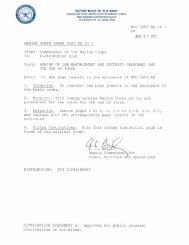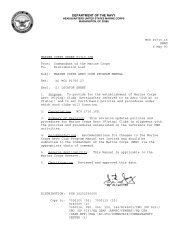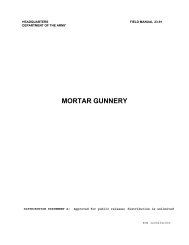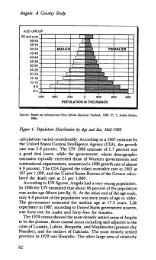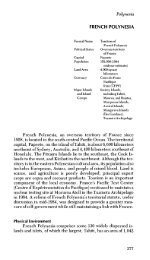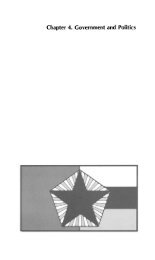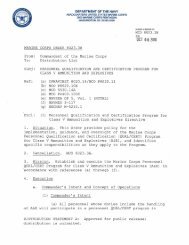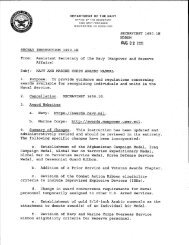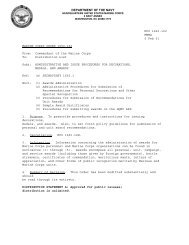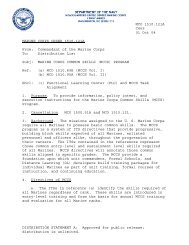US Marines in the Korean War PCN 10600000100_19 - Marine Corps
US Marines in the Korean War PCN 10600000100_19 - Marine Corps
US Marines in the Korean War PCN 10600000100_19 - Marine Corps
Create successful ePaper yourself
Turn your PDF publications into a flip-book with our unique Google optimized e-Paper software.
en Mar<strong>in</strong>e Transport Helicopter Squadron<br />
(HMR) 161 deployed to Korea, <strong>the</strong> squadron<br />
took with it an aircraft that pushed <strong>the</strong> technical<br />
state-of-<strong>the</strong>-art <strong>in</strong> helicopter design <strong>in</strong>to a new frontier.<br />
Designated <strong>the</strong> HRS-1, <strong>the</strong> Sikorsky-designed and<br />
built helicopter had endured <strong>the</strong> <strong>in</strong>evitable ups and<br />
downs that characterized <strong>the</strong> <strong>in</strong>troduction of any pioneer<strong>in</strong>g<br />
aircraft. Without government contracts, <strong>the</strong><br />
Sikorsky Aircraft Division of <strong>the</strong> Vought-Sikorsky<br />
Corporation, Stratford, Connecticut, produced an aircraft<br />
designated <strong>the</strong> S-55, first flown <strong>in</strong> <strong>19</strong>49. Initially market<strong>in</strong>g<br />
<strong>the</strong> aircraft as a commercial utility helicopter, Igor<br />
Sikorsky hoped <strong>the</strong> S-55 could compete with <strong>the</strong> Piasecki<br />
H-21 (or PD-22), which had been adopted by <strong>the</strong> U.S. Air<br />
Force for its air rescue service. The Navy, however, was<br />
<strong>in</strong> <strong>the</strong> hunt for a general-purpose helicopter that could be<br />
adopted for shipboard use. Naval aviators liked <strong>the</strong> S-55<br />
because of its economical design, modest size, and serviceability.<br />
Redesignated <strong>the</strong> HO4S-1 <strong>in</strong> its naval model, <strong>the</strong> S-55<br />
represented at least two major eng<strong>in</strong>eer<strong>in</strong>g advances: <strong>the</strong><br />
addition of a tail rotor for greater stability <strong>in</strong> flight and a<br />
front-mounted Pratt & Whitney R-1340-57 eng<strong>in</strong>e that<br />
could generate a respectable 600 horsepower. The eng<strong>in</strong>e<br />
placement helped solve a nagg<strong>in</strong>g problem of weight-distribution<br />
and flight characteristics. Prior helicopter models<br />
placed <strong>the</strong> eng<strong>in</strong>e directly under <strong>the</strong> rotor-blades, a<br />
design that gravely limited any so-designed helicopter to<br />
Whirlybirds<br />
459<br />
very light loads and <strong>in</strong>sured flight <strong>in</strong>stability. The frontmounted<br />
eng<strong>in</strong>e dramatically <strong>in</strong>creased <strong>the</strong> helicopter's<br />
carry<strong>in</strong>g capacity and simplified ma<strong>in</strong>tenance s<strong>in</strong>ce <strong>the</strong><br />
HRS-1 hadl clam-shaped nose doors that provided easy<br />
access to <strong>the</strong> eng<strong>in</strong>e for <strong>the</strong> ground crew mechanics. The<br />
new design also improved vertical flight stability.<br />
In <strong>the</strong> earliest stage of evaluation, <strong>19</strong>48-<strong>19</strong>49, Navy and<br />
Mar<strong>in</strong>e <strong>Corps</strong> officers, encouraged by Sikorsky, saw capabilities<br />
<strong>the</strong> helicopter did not yet have, even under optimum<br />
wea<strong>the</strong>r and altitude conditions. The orig<strong>in</strong>al<br />
requirement <strong>the</strong> naval aviators placed on <strong>the</strong> helicopter<br />
was a 10-man load (225 pounds per Mar<strong>in</strong>e) to be carried<br />
150 miles. The requirements shrank, as it became more<br />
and more obvious that <strong>the</strong> HRS-1 was not go<strong>in</strong>g to be a<br />
two-ton-plus lifter. All <strong>the</strong> helicopter's o<strong>the</strong>r characteristics,<br />
however, made it <strong>the</strong> aircraft of choice for <strong>the</strong><br />
Bureau of Aeronautics, and <strong>the</strong> Mar<strong>in</strong>e <strong>Corps</strong> jo<strong>in</strong>ed <strong>the</strong><br />
program <strong>in</strong> August <strong>19</strong>50, with an <strong>in</strong>itial order of 40 aircraft.<br />
The HRS-ls that went to Korea came <strong>in</strong>to service with<br />
a gross weight rat<strong>in</strong>g (7,000 pounds at sea level) about<br />
1,000 pounds slighter than orig<strong>in</strong>ally designed with a<br />
payload reduced to 1,420 pounds under optimal flight<br />
conditions. Its troop load dropped from 10 to four to six.<br />
The helicopter's maximum speed rema<strong>in</strong>ed at 90 knots,<br />
but its range had dropped by half to 70-mile round trips.<br />
Never<strong>the</strong>less, <strong>the</strong> HRS-1 was not a "whirlybird" of dlisappo<strong>in</strong>tment,<br />
but promise.<br />
National Archives Photo (<strong>US</strong>N) 80-G-433347



